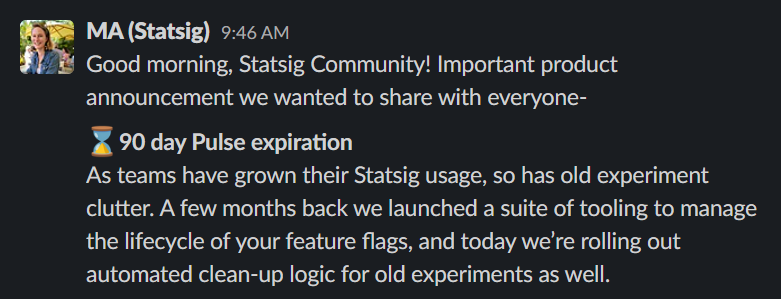
When your customers forthcomingly celebrate the way you support them, it speaks volumes.
Have you ever had an issue with your software that you couldn’t figure out on your own? Do you remember why?
Sure, sometimes the software isn’t working as advertised. Sometimes there are bugs and issues, features that aren’t doing what they’re supposed to do. That’s common.
But what’s more common—at least in my case: Sometimes you have a very specific question and need an expert to talk to.
Chatbots are cool, but I’ve had very little luck actually using them. The second I open the conversation and see a pre-defined list of topics to choose from, my heart sinks. I’m not interested in links to support documentation that I’ve already read.
Furthermore, when connected with a live agent, there’s often not a ton they can do to support me. It feels like a roundabout way of submitting a referral to another department—the one that can actually help me—and my conversation ends with “They’ll email you soon.”
And now it’s time for the waiting game. Since the support I need isn’t publicly available, I need to open a support ticket. And just like that, the timeline of my own project is no longer in my hands.

Well, we at Statsig think this model sucks.
A community of help
"Our quick setup was largely in part to the Slack channel and the solutions engineering team. We joined the Slack channel and it was astounding how fast the team was responding to requests."
Michael Koch, Tempo
How Tempo democratizes fitness

The best support occurs when the company you’re interfacing with feels like a part of the team, and that’s exactly what Statsig achieves.
In order to support our customers best, we invite them to join the Slack community, and even open special side channels just for them.
This way, everyone at an organization can communicate collaboratively and privately with Statsig. Messages happen in real-time, as our support team is always on-call to help out with any customer needs.
"Statsig support has been one of the key parts of our relationship. I’m very satisfied with both the speed and quality of responses in the Slack channel. Sometimes my questions aren’t even about [Statsig], but like ‘how to explain p-value to a non-technical person,’ and Statsig answers those as well!"
Rafael Blay, Rei do Pitaco
Private and public channels

The Slack workspace also has public channels for topics like experimentation, general (public) support, product updates, and more. In these channels, questions and (and even replies!) come from the community at large. Although, yes, you can find a Statsig response on every thread.
"Statsig’s responsiveness to feature requests and questions is what won us over."
Bilal Quadri, Zoya
If looking for support about things that are specific to your company, like setting up your SDKs, a private chat is ideal, but there’s always an opportunity to engage with other experimenters at different companies and “compare notes.”
This type of collaboration keeps everyone sharp, and it’s magical to witness it happening in our Slack community.
Product and feature updates and documentation
In addition to posting product updates on our website, our product managers also regularly post and interact in our community to raise awareness around every new feature that’s launched.

When features are rolled out, users can engage with Statsig in real-time to get clarity and advice around using these features. Sometimes our engineers even write blog posts about them.
Pro tip: We also keep a standing list of product updates that are indexable by date, so they can be easily linked and shared with your team.
Join the Slack community

Public documentation
When a new feature is launched, the team responsible for it will thoroughly document it in our always-public support documentation portal.
We’re proactive about keeping our docs up to date, so that users can self-serve, find answers to questions, and learn more about the features and functionality that will improve their own experimentation velocity.
Separate from our website product descriptions, the support documentation provides deep, technical dives into all areas of the Statsig platform. Here, you can learn about dynamic configs, metrics, layers, segments—whatever you like—and follow descriptive walkthroughs to start experimenting with them at your own pace.
The Statsig promise
We want our users to know that we are here for them. Thanks to the efforts of our stellar support team (Jiakan, Vineeth, Joe, Tyler, and others), our customers can feel like Statsig is a part of their team and not just a software vendor.
"The Statsig team has been there every step of the way, from implementation to understanding results. They are building something special and we are excited to be a part of the journey."
Josh Houghton, Made Renovation
To our community members, experimenting alongside us, we’d like to say thank you, sincerely, for being on this journey with us.
And to those who aren’t yet: What are you waiting for?
Statsig's refer-a-friend program




